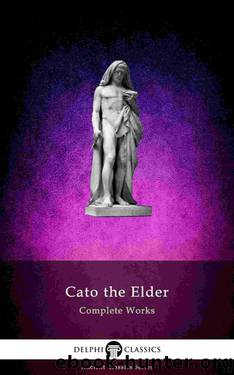Delphi Complete Works of Cato the Elder (Illustrated) (Delphi Ancient Classics Book 67) by Cato the Elder

Author:Cato the Elder [Elder, Cato the]
Language: eng
Format: epub, azw3
Tags: Ancient Classics
Publisher: Delphi Classics
Published: 2016-05-06T20:00:00+00:00
SECTIONS 60-79
[60] Bubus cibaria annua in iuga singula lupini modios centum viginti aut glandis modios CCXL, faeni pondo DXX, ocini, fabae M. XX, viciae M. XXX. Praeterea granatui videto satis viciae seras. Pabulum cum seres, mulas sationes facito.
[60] 1 The following is a year’s ration for a yoke of steers: 120 modii of lupines, or 240 of mast; 520 pounds of hay, and . . . of clover; 20 modii of beans; and 30 modii of vetch. See also that you sow enough vetch to allow some to go to seed. Make several sowings of forage crops.
[61] Quid est agrum bene colere? Bene arare. Quid secundum? Arare. Quid tertium? Stercorare. Qui oletum saepissime et altissime miscebit, is tenuissimas radices exarabit. Si male arabit, radices susum abibunt, crassiores fient, et in radices vires oleae abibunt. Agrum frumentarium cum ares, bene et tempestivo ares, sulco vario ne ares. Cetera cultura est multum sarire et diligenter eximere semina et per tempus radices quam plurimas cum terra ferre; ubi radices bene operueris, calcare bene, ne aqua noceat. Siquis quaeret, quod tempus oleae serendae siet, agro sicco per sementim, agro laeto per ver.
[61] 1 What is good cultivation? Good ploughing. What next? Ploughing. What third? Manuring.
The planter who works his olives very often and very deep will plough up the very slender roots; while bad ploughing will cause the roots to come to the surface and grow too large, and the strength of the tree will waste into the roots. When you plough grain land do it well and at the proper season, and do not plough with an irregular furrow. The rest of the cultivation consists in hoeing often, taking up shoots carefully, and transplanting, at the proper time, as many roots as possible, with their soil. When you have covered the roots well, trample them firmly so that the water will not harm them. If one should ask what is the proper time for planting olives, I should say, at seed-time in dry ground, and in spring in rich ground.
[62] Quot iuga boverum, mulorum, asinorum habebis, totidem plostra esse oportet.
[62] 1 You should have as many carts as you have teams, either of oxen, mules, or donkeys.
[63] Funem torculum esse oportet extentum pedes LV, funem loreum in plostrum P. LX, lora retinacula longa P. XXVI, subiugia in plostrum P. XIIX, funiculum P. XV, in aratrum subiugia lora P. XVI, funiculum P. VIII.
[63] 1 The press rope should be 55 feet long when stretched; there should be 60 feet of leather cordage for the cart, and 26 feet for reins; the yoke straps for the cart 18 feet, and the line 15; the yoke straps for the plough 16 feet and the line 8.
[64] Olea ubi matura erit, quam primum cogi oportet, quam minimum in terra et in tabulato esse oportet. In terra et in tabulato putescit. Leguli volunt uti olea caduca quam plurimum sit, quo plus legatur; factores, ut in tabulato diu sit, ut fracida sit, quo facilius efficiant. Nolito credere oleum in tabulato posse crescere.
Download
Delphi Complete Works of Cato the Elder (Illustrated) (Delphi Ancient Classics Book 67) by Cato the Elder.azw3
This site does not store any files on its server. We only index and link to content provided by other sites. Please contact the content providers to delete copyright contents if any and email us, we'll remove relevant links or contents immediately.
The Daily Stoic by Holiday Ryan & Hanselman Stephen(3239)
The Fate of Rome: Climate, Disease, and the End of an Empire (The Princeton History of the Ancient World) by Kyle Harper(3007)
People of the Earth: An Introduction to World Prehistory by Dr. Brian Fagan & Nadia Durrani(2702)
Ancient Worlds by Michael Scott(2628)
Babylon's Ark by Lawrence Anthony(2622)
The Daily Stoic by Ryan Holiday & Stephen Hanselman(2466)
Foreign Devils on the Silk Road: The Search for the Lost Treasures of Central Asia by Peter Hopkirk(2435)
India's Ancient Past by R.S. Sharma(2417)
MOSES THE EGYPTIAN by Jan Assmann(2374)
The Complete Dead Sea Scrolls in English (7th Edition) (Penguin Classics) by Geza Vermes(2238)
Lost Technologies of Ancient Egypt by Christopher Dunn(2196)
The Earth Chronicles Handbook by Zecharia Sitchin(2184)
24 Hours in Ancient Rome by Philip Matyszak(2053)
Alexander the Great by Philip Freeman(2035)
Aztec by Gary Jennings(1977)
The Nine Waves of Creation by Carl Johan Calleman(1885)
Curse Tablets and Binding Spells from the Ancient World by Gager John G.;(1839)
Before Atlantis by Frank Joseph(1814)
Earthmare: The Lost Book of Wars by Cergat(1793)
